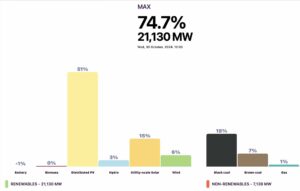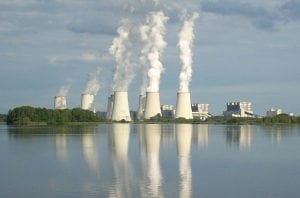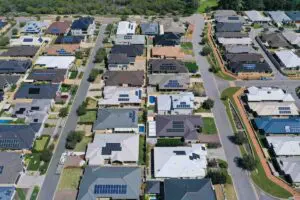The NSW state Labor government has confirmed that its controversial decision to delay the closure of the country’s biggest coal fired power generator at Eraring was primarily driven by concerns over a possible jump in wholesale electricity prices.
The 2.88 gigawatt (GW) Eraring facility on the central coast was due to close on August, 2025, but under an underwriting deal with the state government which could be worth up to $450 million, Origin Energy will now keep at least two units open until August, 2027, a few months after the next state election.
As Renew Economy has written on many occasions, this decision was always about price rather than the threat of a supply shortfall, which the Australian Energy Market Operator said was unlikely to occur if government tendered projects for new wind, solar and battery storage were delivered on time.
But the failure of Eraring owner Origin Energy to build any new capacity in NSW before the 2025 closure, and delays caused by planning, connection, and commissioning holdups to other projects forced the state government’s hand.
Modelling that the Minns government relied upon – produced by Endgame Economics and ICA Partners – has now been released (or at least bits of it) – and confirms that the greatest benefit of the delayed closure would come from lower prices.
A summary of the Endgame analysis tabled in parliament on Tuesday suggests that the savings on wholesale market prices would total $4.4 billion, with a relatively small benefit of $300 million allocated to increased energy security and $200 million for avoided system strength measures.
The report says this would outweigh the $1.1 billion negative benefits from higher emissions resulting from the burning of more coal, and other costs of $600 million, including $400 million in payments to Origin. Overall, it puts the net benefits at $3.2 billion to $3.5 billion.
“Delaying Eraring’s closure will place downward pressure on wholesale electricity prices,” an excerpt from the report says.
“Energy market modelling price forecasts indicates that if Eraring continues to operate to August 2027, time-weighted average wholesale electricity prices are expected to be around $55 per megawatt-hour lower in 2025-26 and $40 per megawatt-hour lower in 2026-27 than if Eraring were to close in August 2025.”
The full report by Endgame remains commercial in confidence, and so apparently the full modelling and the assumptions it was working on won’t be released. That’s unfortunate, because it is pretty clear that the modelling has already been mugged by reality.
For a start, the numbers cited above, Endgame points out, were made on the assumption that Eraring was to close in late 2028, which is what it was asked to model – confirming speculation at the time that NSW was looking for a longer delay.
It means that the wholesale price benefit is more likely to be less than $3 billion under the deal actually negotiated, and it is not clear that those benefits will actually occur.
The claimed benefits are questionable because in the month of May NSW had a taste of what happens when the number of coal units is reduced (in this case due to unplanned outages at Eraring and various failures elsewhere), and when the big generation companies – Origin, AGL, EnergyAustralia and Snowy Hydro – exercise their control over the market.
In May the prices were driven to the market cap so often that the market had to be suspended, and an administrative price imposed. In a detailed report, the Australian Energy Regulator blamed re-bidding and possibly deliberately slow ramping rates for the price spikes.
“While rebidding to maximise profits is permissible under the National Electricity Rules, the behaviour may not have been in the best interests of energy consumers,” the AER noted.
In a later report, both the AER and AEMO noted that without those engineered price spikes, the average cost of wholesale electricity in NSW would have actually fallen in the June quarter, rather than jumping by 25 per cent as it did, to an average of more than $150/MWh.
There is no guarantee this won’t happen on repeated occasions into the future. Wholesale prices in NSW went to the market cap of $17,500/MWh on Monday evening, and last week – for the first time – wholesale prices were above $15,000 MWh in all five states at the same time.
Again, this had nothing to do with the actual cost of generation or the prospect of a supply shortfall, it was simply lack of competition.
This situation is being ruthlessly exploited by the big market players who are busily hoovering up – through long term contracts – the operational rights of most of the new capacity, particularly battery storage, that is being brought to market and which might have introduced more competition.

The futures market agrees. It has already pushed the anticipated wholesale price of electricity in NSW in 2026 and 2027 way beyond the price modelled by Endgame. If the futures market is right, then it is highly unlikely that the assumed benefits will be delivered, and NSW and its customers will be left with the cost of higher emissions.
Tim Buckley, from Climate and Energy Finance, was withering in his critique of the NSW decision and the modelling outcome.
“Does this analysis assume they (the NSW government) stand there like startled rabbits in the headlights and do absolutely nothing for a couple of years in the face of the stark knowledge that the largest coal fired power plant is at the end of its useful life and going to close?” Buckley wrote on LinkedIn.
“The permanent solution is not bandaids and more taxpayer subsidies for an end of life, unreliable high emissions coal clunker. $450m of tax payer monies would have crowded in a lot of permanent, low cost, zero emissions private projects.”
Buckley noted that one of the main options for NSW is to accelerate the rollout of distributed energy resources at scale, and by leveraging the existing grid.
“It is about deciding there is an Overriding Public Interest in getting the coal luddites out the planning department and putting in staff that can evaluate and approve critically needed new infrastructure projects at speed and scale to solve the energy, cost of living and climate crisis,” Buckley wrote.
“It is not hard. But clearly it is beyond this NSW Government. How many new renewable energy projects has Minister Paul Scully approved this year?? We are waiting, and waiting. And we all continue to pay the price.”










